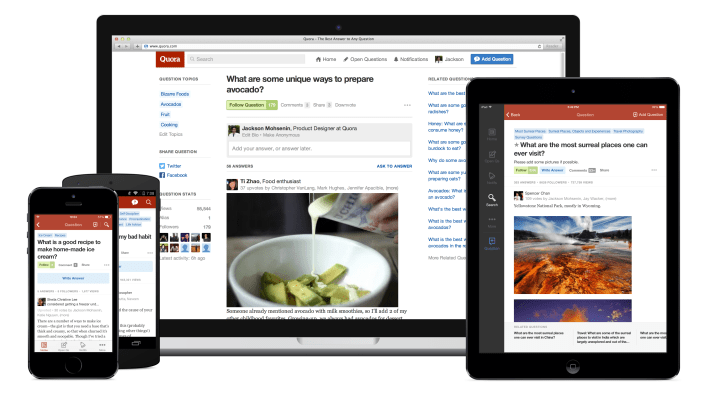Quora wants to be the place where people share their knowledge with the world, and that means being on all the devices that people around the world use. To date, that’s meant the web, mobile web, and some native apps for iPhone and Android. Today the company is finally making its Q&A platform available on the iPad, extending its reach onto the last major device platform it didn’t have a mobile app for.
The release of the new app has been a long time coming. After all, Quora first launched its iPhone app nearly three years ago. It appeared on Android devices about a year after that.
So why did it take so long to reach the iPad? Quora CEO and co-founder Adam D’Angelo says the delay has mostly been due to the constraints of working with a relatively small team. Quora had building the new app over the last six months, but first the company did a lot of work to create a new, unified design to be used across the web and mobile apps.
Before releasing the new app, Quora’s team introduced a new web experience, which was slowly rolled out to users over the last several weeks.
Most of the work was done on the back end and behind the scenes to improve the experience across platforms. Now that the company knows it works, Quora is going to be extending the same experience to other devices over time, starting with the iPad.
With the launch of the new app, Quora sought to create the best experience for asking and answering questions on its platform. It’s helped by the size of the device, which gives it a bigger palette to work with. As a result, it makes reading answers easier, and those which contain rich media or formatting really shine.
Quora has done some work to make asking and answering questions even easier on the new app, however. When asking a question, Quora allows you to view other similar questions that others have already asked — saving you time and helping you find an answer rather than duplicating efforts.
When answering, meanwhile, Quora has attempted to inspire users to incorporate images and formatting into their responses. To do that, Quora has built out a custom keyboard that has rich formatting functions built in, enabling users to easily add images, bullets points, or rich text into their answers.
The hope is not only to reach new users, but to inspire those new users to answer questions. It’s those questions, after all, that are mostly driving the company’s growth.

Under The Radar Growth
We don’t often hear from Quora, but when we do, it generally has some news about a new product or feature, or some growth metrics, or maybe a big round of funding. The company’s MO is generally to keep quiet unless and until it has something to say.
That generally leads some to believe that Quora has been a bit of an underachiever. But just because Quora has been quiet doesn’t mean it hasn’t been growing.
In fact, according to D’Angelo, nothing could be further from the truth. He says the startup had its best week ever across all of the metrics it cares about last week — and that’s all being driven by a dramatic increase in the answers that have been added to its platform.
That number has tripled over the past year, which is leading both new and existing members to contribute more than ever before. He posits that even if it were to stop accepting new members tomorrow, based on its current trajectory the number of answers it will receive this year will surpass all those submitted during the first four and a half years of Quora’s existence.
For a startup that is dependent on content from its community to keep it going and keep it relevant, that’s good news.
Having more answers doesn’t just provide Quora with more content for its readers to look at or more hooks into the site from search engines or third-party sites. The increased scale also enables Quora to better match its users with content that is relevant to them and questions they can answer.
That in turn inspires some readers to write more answers, which contributes to a virtuous cycle within the Q&A site. Early on Quora’s content mostly related to the early adopter tech set, but now it’s seeing a larger group of users responding to a much wider variety of topics.
But rather than optimizing for SEO, like all previous Q&A sites, Quora hopes to optimize for quality. The thinking goes that quality begets quality, with Quora users seeing good answers and wanting to provide some of their own.
“In general, the other Q&A services have not really focused on quality,” D’Angelo says. As a result, “you end up with a lot of answers being written, but they’re not really useful to people… If you’re serious about writing answers, you want to write somewhere that takes good care of your content and make good use of tools.”
Anyway, collecting all the world’s knowledge is a noble pursuit, but the reality is that at some point the company will have to make some money to justify its valuation.
It’s able to delay monetization in part because it’s raised so much money. The $80 million Series C round that the company raised earlier in the spring brought total funding to $160 million raised over the last four-and-a-half years.
Quora still hasn’t begun monetizing its site in earnest, but when it does, it’s likely to be ad-driven. D’Angelo says the company right now is totally focused on growth. But when monetization does come into play, it has a lot of intent in its usage, which means it will be able to charge a premium for advertisers looking to reach certain users.
